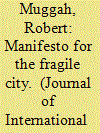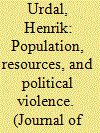|
|
|
Sort Order |
|
|
|
Items / Page
|
|
|
|
|
|
|
| Srl | Item |
| 1 |
ID:
138408


|
|
|
|
|
| Summary/Abstract |
After more than a century of steady city expansion in northern countries, the direction of twenty-first century population growth is shifting southwards. Over the next five decades, Africans, Arabs, and Asians will migrate in unprecedented numbers to cities, especially to their slums. Many of these urban settlements are insecure, disorganized, and violent. These are fragile cities and such migrations can threaten their inhabitants, countries, and the wider neighborhood. The analytical focus on fragile cities offers a novel scale when compared to fragile and failing states. It is also one that is preoccupying national policymakers, military strategists, and development experts. Drawing on theoretical and empirical contributions from geography, criminology, and sociology, this article identifies four mega-risks shaping urban fragility—the transformation and concentration of violence, turbo-urbanization, youth bulges, and the relentless penetration of new technologies. It also considers successful approaches to reversing city fragility, including twinning fragile cities with healthier and wealthier ones, investing in hotspot policing, interventions addressing at-risk youth, support for inclusive and cohesive urban growth, and the targeted application of new technologies.
|
|
|
|
|
|
|
|
|
|
|
|
|
|
|
|
| 2 |
ID:
165350


|
|
|
|
|
| Summary/Abstract |
This article examines the impact of youth bulges and the lack of perspective of this cohort associated with the insufficient absorption of the labor market on the emergence of piracy acts. For a large panel data-set on maritime piracy and armed robbery against ships for the period 1990–2015 negative binomial regression results indicate that a large fraction of young people in a country increases the likelihood of piracy attacks originating from that country. Further, the piracy-driving effect is conditional on constrains in the labor market. It increases when the young population is insufficiently integrated into the labor market and becomes insignificant for high levels of labor force participation. The dearth of prospects seems to lower the inhibition to make a living from criminal activity.
|
|
|
|
|
|
|
|
|
|
|
|
|
|
|
|
| 3 |
ID:
082937


|
|
|
|
|
| Publication |
2008.
|
| Summary/Abstract |
Recent cross-national studies have found only moderate support for the idea that population pressure and resource scarcity may lead to political violence, contrary to much of the case study literature in the field. This article suggests that the level of analysis may be at the heart of this discrepancy. In a time-series study of political violence in 27 Indian states for the 1956-2002 period, it is tested whether high population pressure on renewable natural resources, youth bulges, and differential growth rates between religious groups are associated with higher levels of armed conflict, political violent events, and Hindu-Muslim riots. The results are generally more supportive of the resource scarcity and conflict scenario than recent global studies. The article further suggests that youth bulges affect all three forms of violence and that differential growth rates are positively related to armed conflict.
|
|
|
|
|
|
|
|
|
|
|
|
|
|
|
|
|
|
|
|
|